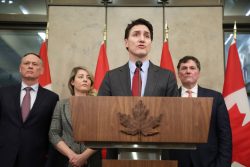On June 1, it was announced that the City Mall at Camp and Regent streets had been re-opened for business ahead of the June 3 expiration of the national COVID-19 measures. The re-opening of the Mall came against the backdrop of what had been a period of clearly discernable pressure from the business community on the basis of an understandable argument that the protracted closure of businesses had created an economic squeeze for business owners as much as for employees.
There had always been a concern, however, that, on the whole, the strictures that had earlier been put in place, social distancing, particularly, had not been scrupulously adhered to over time, here in Guyana, and that any general re-opening of businesses in the absence of an ‘all clear’ from the medical authorities might be ill-advised.
The closure of the City Mall had appeared to work to some extent to ease the practice of knots of people – taxi drivers, vendors, shoppers and ‘limers,’ either gathered in tight groups around that Camp and Regent streets junction or trying to navigate the congestion. With the Mall re-opening on Monday June 2 some of those scenes were restored almost immediately… shoppers, taxi drivers, ‘limers’, and street vendors all returned to make their presence felt in a manner that might have caused one to think that Guyana (or at least that particular part of the capital) had been declared COVID-19 free!
Worryingly, not a few of the ‘happy campers’ on the junction appeared mindful of the fact that social distancing remains a strongly recommended pursuit. The closeness was worryingly evident and the limited use of face masks was, to say the least, perplexing. A week ahead all of this is likely to be added to when, as was announced last week, Grades Six, Eleven and Twelve children return to school on Monday. Many of them must traverse the Camp and Regent streets’ area on foot, on their way to and from school.
One must of course make the point that the temptation to ‘force the issue’ insofar as ‘managing’ a return to normalcy is understandable. The arguments for returning trading to a condition of normalcy, restoring those displaced workers to their jobs and moving towards a full re-instatement of education delivery are all important considerations. These considerations must all, however, be contemplated and managed against the backdrop of the attendant risks. The view has been expressed, for example, that the lifting of strictures in some countries, Trinidad and Tobago, being an example, had come against the backdrop of a prior application and effective enforcement of lockdown-type measures and that these may have resulted in lower infection and fatality rates as far as COVID-19 was concerned. Truth be told, it is not generally felt that we in Guyana have, up until now, demonstrated a sufficient level of mindfulness of the importance of the social distancing and other considerations associated with trying to limit the spread of the virus. So that now that we appear to be edging towards a removal of restrictions the health authorities must say what our own ‘numbers’ are telling us about the wisdom of what now appears to be a kind of incremental re-opening for business. It is the responsible thing to do.
The case of the business community, one again restates, carries with it a validity that cannot be faulted on business and humanitarian grounds. Nor can – in the case of the education sector – the consequences of having tuition and examinations compromised not be taken account of. Everything, however, must, of necessity, be balanced against an informed ability to measure risk. The desirability for a ‘freeing up’ and a restoration of normalcy in areas, like education and commerce, ought, surely, to be attended by strictly overseen measures designed to ensure that those decisions do not deliver an unwanted backlash.
What would doubtless be helpful at this stage would be –with the lifting of some strictures now underway – clear public pronouncements from the health authorities amounting to assurances that the removal of these is taking place against the backdrop of risk analyses that provide a fair measure of assurance to those who may feel that they we are going too far, too fast. After all, the daily updates that we continue to receive from the global health authorities point unerringly to the fact that the COVID-19 storm is far from over.








